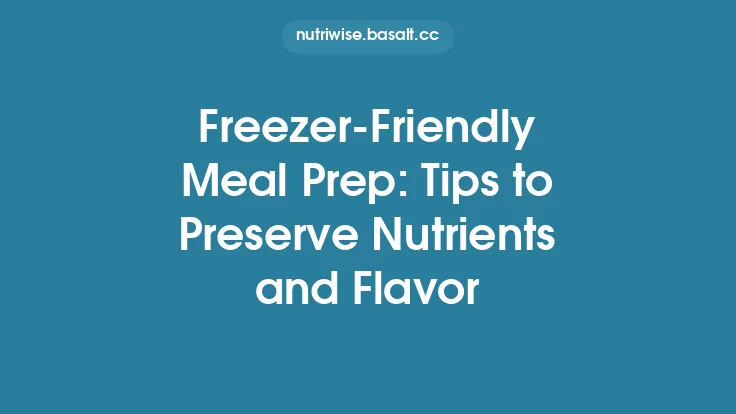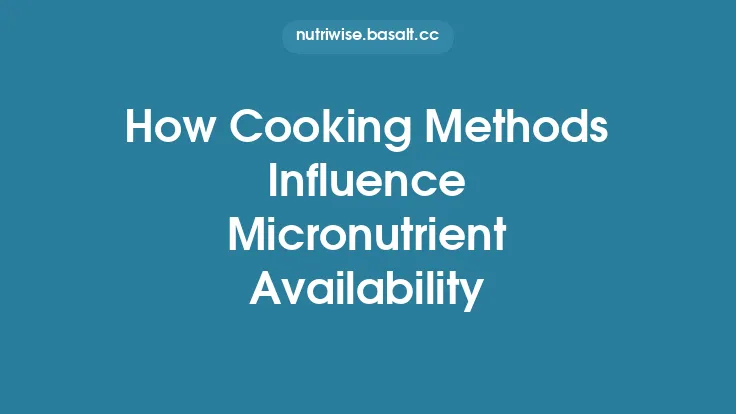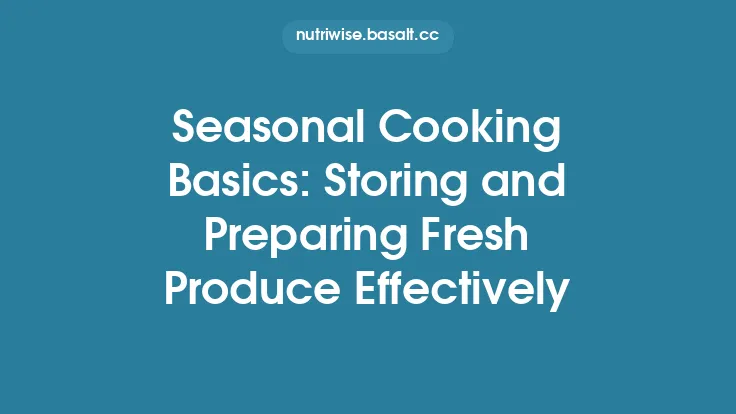Blanching is a culinary technique that involves briefly immersing vegetables, fruits, or even nuts in boiling water (or steam) and then rapidly cooling them in an ice‑water bath. Though the process lasts only seconds to a few minutes, it triggers a cascade of biochemical changes that lock in vivid color, preserve texture, and safeguard a substantial portion of the food’s vitamins, minerals, and phytonutrients. Because blanching is essentially a controlled “heat shock,” it occupies a unique niche among nutrient‑preserving cooking methods: it is fast enough to limit leaching of water‑soluble compounds, yet hot enough to deactivate the enzymes that would otherwise degrade quality during storage.
The Science Behind Color Retention
Enzyme Inactivation
The bright greens of broccoli, spinach, and green beans are largely due to chlorophyll, a pigment that is highly sensitive to the enzyme chlorophyllase. When vegetables are harvested, chlorophyllase remains active and can convert chlorophyll into pheophytin, a dull olive‑brown pigment. A brief exposure to temperatures of 85 °C–100 °C denatures chlorophyllase, halting this conversion and preserving the vivid green hue.
pH Stabilization
Blanching also influences the pH of the vegetable’s cellular environment. By briefly raising the internal temperature, the cell membranes become more permeable, allowing organic acids to diffuse out and stabilizing the pH around neutral. This neutral pH environment further protects anthocyanins and carotenoids from acid‑catalyzed degradation.
Structural Firmness
Heat causes pectin substances in the middle lamella to soften just enough to loosen cell walls without causing complete breakdown. This partial softening locks in turgor pressure, giving blanched vegetables a crisp‑tender bite that resists the mushiness that can develop during long‑term storage.
Nutrient Preservation Mechanisms
| Nutrient | Primary Threat | How Blanching Helps |
|---|---|---|
| Vitamin C (ascorbic acid) | Oxidation by polyphenol oxidase (PPO) and ascorbate oxidase | Rapid enzyme inactivation reduces oxidative loss; short exposure limits leaching. |
| B‑vitamins (thiamine, riboflavin, niacin) | Heat‑sensitive hydrolysis and leaching | Minimal water contact time curtails leaching; temperature is kept just below the point of rapid degradation. |
| Carotenoids (β‑carotene, lutein) | Oxidative breakdown and isomerization | Heat softens cell walls, making carotenoids more bioavailable while enzyme inactivation prevents oxidative chain reactions. |
| Phenolic compounds | Polyphenol oxidase activity | PPO is denatured within seconds, preserving antioxidant capacity and color. |
| Minerals (potassium, magnesium, calcium) | Leaching into cooking water | Short immersion limits mineral loss to negligible levels (<5%). |
The net effect is that blanching can retain 70 %–90 % of heat‑sensitive nutrients, a far higher retention rate than many longer cooking methods.
Determining Optimal Time and Temperature
- Identify the Produce – Different vegetables have varying thicknesses, cell wall compositions, and enzyme loads. For example, thin‑skinned peas require 30 seconds, while dense carrots may need 3 minutes.
- Consult Standardized Tables – Culinary science institutions provide blanching charts that list precise times at a rolling boil (100 °C). These tables are derived from kinetic studies of enzyme inactivation (e.g., a 90 % reduction in PPO activity).
- Adjust for Altitude – Boiling point drops about 1 °C for every 300 ft increase in elevation. Compensate by extending the blanching time by 10 %–15 % at high altitudes.
- Use a Thermometer – Verify that the water is at a vigorous rolling boil before adding produce. A digital probe can confirm that the internal temperature of the vegetable reaches at least 85 °C within the first 30 seconds.
- Trial Runs – Conduct a quick sensory test: after shocking, taste a piece. It should be bright, crisp, and free of raw flavor. If it’s too soft, reduce time; if it’s still pale, increase by 10 seconds.
Practical Steps: From Pot to Ice Bath
- Prepare the Ice Bath – Fill a large bowl with water and ice cubes (ratio 1:1). The bath should be at or below 5 °C to halt cooking instantly.
- Boil the Water – Use a wide, shallow pot to ensure even heat distribution. Add a pinch of salt (optional) to raise the boiling point slightly and improve flavor.
- Load the Produce – Place vegetables in a perforated basket or a stainless‑steel colander. Submerge quickly to avoid temperature drop.
- Time Precisely – Start the timer the moment the produce contacts the water. Use a digital timer for accuracy.
- Shock Immediately – Using tongs or a slotted spoon, transfer the blanched items to the ice bath within 2 seconds. Stir gently to ensure uniform cooling.
- Drain and Dry – After 2–3 minutes in the ice bath, remove the produce and pat dry with a clean kitchen towel or a salad spinner. Excess moisture can cause ice crystal formation during freezing.
Variations for Different Produce Types
| Produce | Typical Blanch Time | Special Considerations |
|---|---|---|
| Leafy greens (spinach, kale) | 30 seconds | Use a large basket to avoid crowding; add a splash of lemon juice to the ice bath to preserve chlorophyll. |
| Cruciferous (broccoli, cauliflower) | 2–3 minutes | Salt the water (½ tsp per litre) to enhance flavor and maintain firmness. |
| Root vegetables (carrots, parsnips) | 3–5 minutes | Slice uniformly (¼‑inch) for even blanching; consider adding a pinch of baking soda to preserve orange hue. |
| Legumes (green beans, peas) | 1–2 minutes | Blanch in batches to keep water temperature stable. |
| Fruits (apples, peaches) | 30 seconds–1 minute | Use a mild acid (lemon juice) in the ice bath to prevent enzymatic browning. |
| Nuts (almonds, pistachios) | 1 minute | Blanch to loosen skins; follow immediately with a cold rinse to stop cooking. |
Blanching for Freezing and Canning
Freezing
- Why Blanch? Freezing slows enzymatic activity but does not stop it. Pre‑blanching ensures that enzymes are already denatured, preventing off‑flavors, discoloration, and texture loss during months of storage.
- Packaging – After shocking and drying, pack produce in airtight freezer bags, removing as much air as possible. Vacuum sealing is ideal for long‑term quality.
Canning
- Acidic vs. Low‑Acid Foods – For low‑acid vegetables, blanching is a prerequisite before pressure canning. It reduces the microbial load and softens the tissue, allowing heat to penetrate uniformly.
- Processing Times – After blanching, fill jars with hot produce and liquid, leaving the recommended headspace. Process according to the USDA canning schedule for the specific vegetable.
Equipment and Safety Considerations
- Stainless‑Steel or Aluminum Pots – Conduct heat efficiently; avoid non‑stick coatings that can degrade at high temperatures.
- Perforated Baskets/Colanders – Facilitate quick removal and minimize splashing.
- Thermal Gloves – Protect hands when handling hot baskets or transferring produce.
- Ventilation – Boiling water releases steam; ensure adequate kitchen ventilation to prevent excess humidity.
- Water Quality – Use filtered water to avoid mineral deposits that can affect blanching consistency.
- Food Safety – Discard water after blanching if it becomes cloudy, as it may contain leached nutrients and enzymes.
Common Mistakes and How to Fix Them
| Mistake | Consequence | Remedy |
|---|---|---|
| Over‑blanching | Loss of texture, nutrient leaching, dull color | Reduce time by 10‑15 seconds; use a timer. |
| Under‑blanching | Enzymes remain active, leading to discoloration and off‑flavors during storage | Increase time; verify water is at a rolling boil. |
| Skipping the Ice Bath | Continued cooking, resulting in mushy texture and nutrient loss | Always have an ice bath ready; transfer immediately. |
| Crowding the Pot | Water temperature drops, causing uneven blanching | Blanch in batches; keep pot size appropriate to volume. |
| Using Cold Water for Shock | Not cold enough to halt cooking, especially for dense vegetables | Add enough ice to keep bath temperature ≤5 °C. |
| Leaving Produce Wet Before Freezing | Ice crystals form, damaging cell walls | Pat dry thoroughly; use a salad spinner for leafy greens. |
Frequently Asked Questions
Q: Does adding salt to the blanching water improve nutrient retention?
A: Salt raises the boiling point slightly and can enhance flavor, but it does not significantly affect nutrient retention. The primary factor is the rapid inactivation of enzymes.
Q: Can I reuse blanching water for soups?
A: Reusing water is possible, but it will contain leached nutrients and enzymes, which may affect flavor and clarity. For optimal nutrition, use fresh water.
Q: Is blanching necessary for all frozen vegetables?
A: Commercially frozen vegetables are typically blanched before packaging. If you freeze vegetables at home, blanching is strongly recommended to match the quality of store‑bought products.
Q: How does blanching affect anti‑nutrients like oxalates?
A: Short‑term blanching can reduce soluble oxalates by up to 30 %, but longer cooking methods are more effective for substantial reduction.
Q: Can I blanch directly in a microwave?
A: Microwaving can heat vegetables quickly, but it does not provide the uniform, high‑temperature shock needed for reliable enzyme inactivation. Traditional boiling remains the gold standard for blanching.
Summary
Blanching is a deceptively simple yet scientifically robust technique that safeguards the visual appeal, texture, and nutritional integrity of a wide array of plant foods. By delivering a brief, high‑temperature burst followed by an immediate ice‑water shock, blanching:
- Denatures key enzymes (e.g., polyphenol oxidase, chlorophyllase) that would otherwise degrade color and nutrients.
- Locks in water‑soluble vitamins by limiting leaching through precise timing.
- Preserves mineral content and enhances the bioavailability of carotenoids and phenolics.
- Prepares produce for long‑term storage (freezing, canning) without compromising quality.
Mastering the timing, temperature, and post‑blanching steps empowers home cooks and food professionals alike to deliver vibrant, nutrient‑dense dishes that stand the test of time. Whether you’re prepping a week’s worth of vegetables for the freezer or preserving a seasonal harvest, blanching remains an indispensable tool in the health‑focused culinary arsenal.





